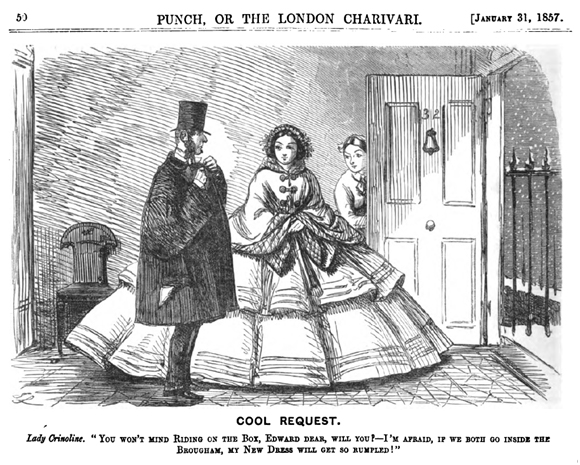By Karen Abbott (Regular Contributor)
Perils of the Era
In addition to smallpox, cholera, and consumption, Victorian era denizens had to consider the perils of crinoline, the rigid, cage-like structure worn under ladies’ skirts that, at the apex of its popularity, reached a diameter of six feet. The New York Times first reported the phenomenon of crinoline-related casualties in 1858, when a young Boston woman, standing by the mantel in her parlor, caught fire and within minutes was entirely consumed by flames—an unfortunate incident that came on the heels of nineteen such deaths in England in a two-month period. Witnesses, impeded by their own crinolines, were forced to watch the victims burn. “Certainly an average of three deaths per week from crinolines in conflagration,” the Times admonished, “ought to startle the most thoughtless of the privileged sex.” A similar tragedy occurred shortly thereafter in Philadelphia, when nine ballerinas burned to death at the Continental Theatre.
Non-fatal consequences of crinoline included entanglement in carriage wheels and being toppled by strong winds, often with mortifying consequences. Such was the case with Consuelo Montagu, the Duchess of Manchester, who snagged her hoops while climbing over a stile and landed upside down, revealing a pair of scarlet knickers. “I wish that people who wear crinoline could see the indecency of their own dress as other people see it,” wrote Florence Nightingale in her 1859 book, Notes on Nursing: What It Is, and What It Is Not. “A respectable elderly woman stooping forward, invested in crinoline, exposes quite as much of her own person to the patient lying in the room as any opera dancer does on the stage. But no one will ever tell her this unpleasant truth.”
Advantages (In the Face of Sartorial Danger)
Nevertheless, crinoline offered some marked advantages over the traditional mode of dressing. It was much lighter and cooler than numerous petticoats suspended from a corseted waist, and, with the invention of the sewing machine in the 1850s, was able to be mass-produced. At the onset of the Civil War, resourceful Southern women discovered new and unexpected benefits of the contraption when they “ran the blockade,” circumventing President Lincoln’s strategy of preventing goods from reaching the Confederate states. One managed to conceal inside her hoop skirt a roll of army cloth, several pairs of cavalry boots, a roll of crimson flannel, packages of gilt braid and sewing silk, cans of preserved meats, and a bag of coffee—the contraband tally for a single crossing. Others tied sabers and pistols around the coils, smuggling small arsenals across the lines. Northern newspapers regularly described the “Secesh in petticoats” who artfully stuffed dozens of bottles of precious quinine beneath their skirts.
The backlash against crinoline intensified during and after the war. Ministers took to the pulpit to warn that wearing hoops was akin to renouncing Christianity. The fad was a “social evil” almost on par with smoking, spitting, and whoring, and women who wore crinoline did so with complete disregard for society. “We have seen the choicest flowers in our gardens and the most cherished plants in our greenhouses cut off by the hoop,” opined The Guardian. “Our wardrobes afford no room for our cloths, because the women of the family want more space than they can get. For five years we have no had room to turn ourselves round in our own homes.” The crinoline craze, or “crinolinemania,” as it was called, waned in the late 1860s, only to threaten revival thirty years later during what would become the heyday of the bustle (Mrs. Grover Cleveland was adamantly anti-crinoline), and again in the 1910s, just before the flapper would change women’s fashion for good. “Greatly daring are the women of today,” declared the New York Times in 1925. “And how they pity their ancestors in crinoline.”
Sources:
Books: Alison Gernsheim, Victorian & Edwardian Fashion. New York: Dover Publications, 1981; Susan J. Vincent, The Anatomy of Fashion. New York: Berg, 2009. Florence Nightingale, Notes On Nursing: What It Is, and What It Is Not. London: Harrison, 1859.
Articles: “Christianity and Crinoline.” New York Times, September 15, 1858; “The Shocking Age.” New York Times, September 20, 1925; “Crinoline: A Real Social Evil.” The Guardian, October 16, 1861; “Mrs. Cleveland Against It.” New York Times, February 19, 1893; “The Perils of Crinoline.” New York Times, March 16, 1858; “Secesh in Petticoats.” New York Times, November 2, 1862.

